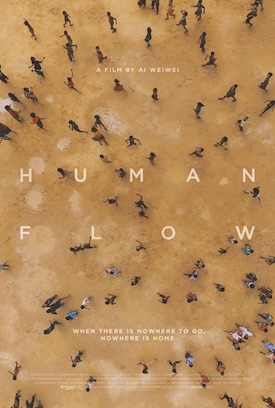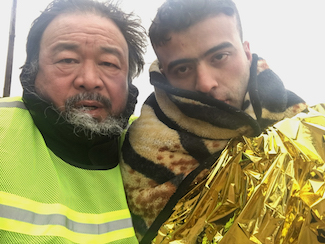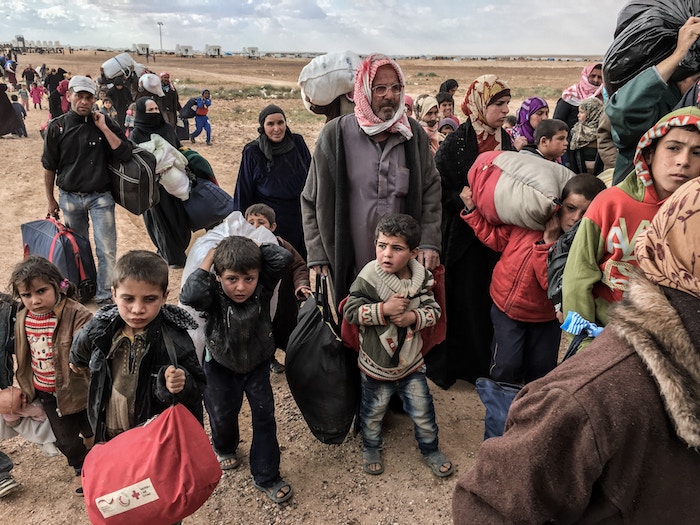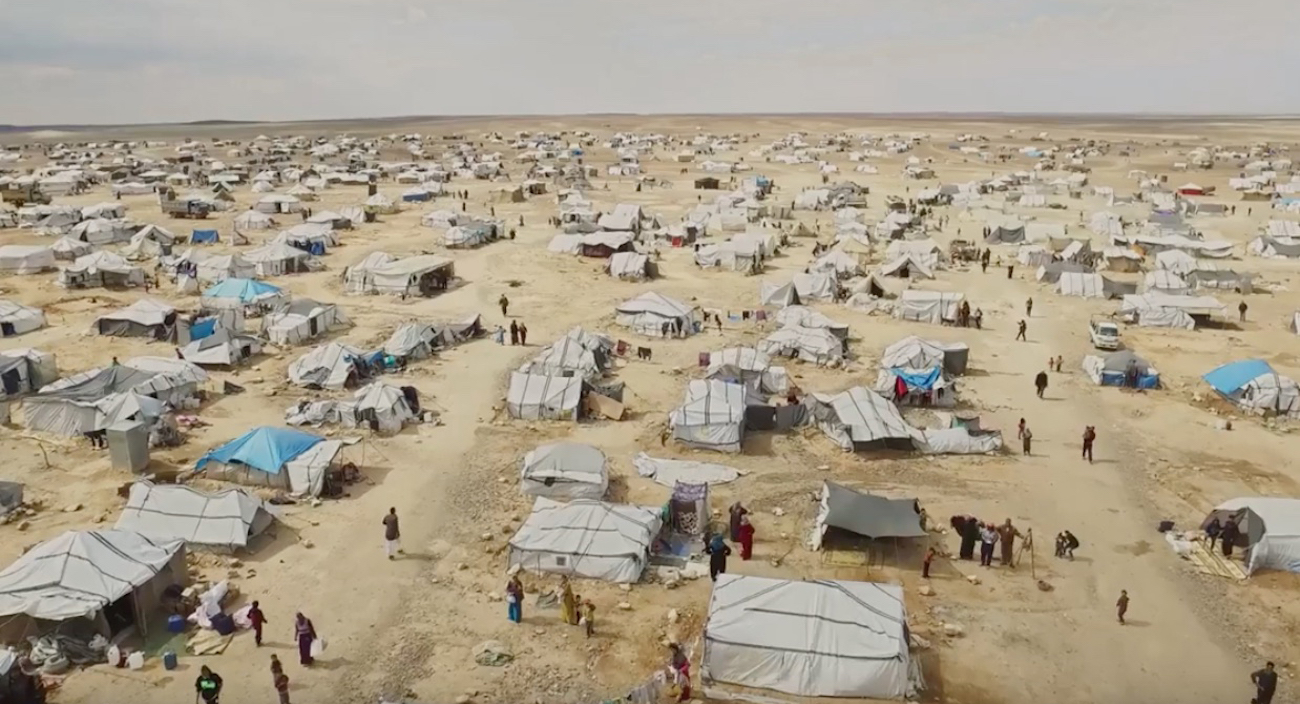 Ai Weiwei’s sweeping new documentary, Human Flow, presents an expansive and moving look at the global refugee crisis. Over 65 million people around the world have been forced from their homes to escape famine, climate change, and war in the greatest human displacement since World War II. In this epic film journey, world-renowned artist and filmmaker Ai Weiwei provides a powerful visual expression to the massive human migration, illustrating both the staggering scale of the refugee crisis and its profoundly personal human impact.
Ai Weiwei’s sweeping new documentary, Human Flow, presents an expansive and moving look at the global refugee crisis. Over 65 million people around the world have been forced from their homes to escape famine, climate change, and war in the greatest human displacement since World War II. In this epic film journey, world-renowned artist and filmmaker Ai Weiwei provides a powerful visual expression to the massive human migration, illustrating both the staggering scale of the refugee crisis and its profoundly personal human impact.
Captured over the course of a year, the film follows a chain of urgent human stories that stretches across the globe in 23 countries including Afghanistan, Bangladesh, France, Greece, Germany, Iraq, Israel, Italy, Kenya, Mexico, and Turkey. Human Flow is a witness to its subjects and their desperate search for safety, shelter, and justice: from teeming refugee camps to perilous ocean crossings to barbed-wire borders; from dislocation and disillusionment to courage, endurance, and adaptation; from the haunting lure of lives left behind to the unknown potential of the future. This film poses one of the questions that will define this century: Will our global society emerge from fear, isolation, and self-interest and choose a path of openness, freedom, and respect for humanity? It was an honor to sit down with Ai Weiwei to talk about this visceral work that is a testament to the human spirit.
Danny Miller: I think I was only about five minutes into this film when I felt like my perspective on refugees was forever altered. This is such an immersive documentary that gets you right in the gut. What were your overall objectives in making the film?
 Ai Weiwei: I really wanted to explore what refugees are by definition. Certainly Syrian refugees are one type, those from Myanmar and Africa could be considered another, and those in Gaza still another. My goal was simply to learn about and capture this flow that has been with us for as long as human beings have existed. What is the nature of this human flow how does it effect our civilization? These are the things that were on my mind.
Ai Weiwei: I really wanted to explore what refugees are by definition. Certainly Syrian refugees are one type, those from Myanmar and Africa could be considered another, and those in Gaza still another. My goal was simply to learn about and capture this flow that has been with us for as long as human beings have existed. What is the nature of this human flow how does it effect our civilization? These are the things that were on my mind.
How did you deal with the massive scope of the project?
It started very early with just my iPhone and a very personal approach, but pretty quickly I realized that the topic was too large for that so we set up research teams to get at the very basic factual truths about human flow in every part of the world and in every part of history. This is a topic that is so rich and profound and one that effects every aspect of the past, from Babel to medieval times to today. It’s about understanding what made us human, understanding how to co-exist with others. For me it’s a constant learning path.
It’s such a compassionate film — and yet I wonder if it was challenging for you to be approaching people at such a difficult moment in their lives?
I think that question comes from our modern-day definition of privacy and personal lives. But think about those refugees. In most cases, they are casualties of war. For years no one has even been recognizing them as individuals. Their lives have become very brutal and they have been denied any status. In most cases they are treated with total indifference. At the beginning, I was a little worried because they are from different cultures, different religions, they speak different languages. I was told I shouldn’t approach any women but you know, I never had a problem. They accepted me. Maybe it was my look, maybe because I was very relaxed when I spoke to them. I approached them in a very gentle way, simply engaging in human communication. I never met a single person who was defensive.
There are so many moments in the film that have stayed with me. The two that come to mind are the woman you’re interviewing who starts to vomit and the boy holding the sign that says “Respect” who is crying behind the sign. Was it hard to keep your own emotions in check during the filming?
You have to kind of train yourself to be a rock. It would have been impossible to do if I had expressed all the emotions I was feeling. It was very hard to work on a film like this because you struggle yourself. I went through a lot of self-judgment during the course of the film — and that’s a lot more challenging than figuring out how to film in dangerous areas.

Did you get any pushback from the countries in which you filmed? Obviously the film doesn’t always show their governments or policies in the most positive light.
Oh, there were many difficult moments — the authorities don’t want to let you in, they don’t want you to approach anyone, or they will refuse to let you do this or that, but that’s fine, we just did what we did. We felt it was absolutely necessary to tell the world what this landscape is all about. We’ll see what happens when the film comes to certain areas, such as Turkey or Israel — how some people will look at it. I’m really not sure how it will be received, to be honest. But we needed to make the film, we needed to speak the truth and to help people who have no voice. That’s all I had on my mind during the process.
As you know, what’s going on in this country right now related to this topic is just a horror show. Refugees are being vilified by our president and others in all sorts of horrible ways. Do you have hopes that your film might help change that conversation here?
Well, I hope it will help some people to get a better perspective about the global refugee situation. Human flow is a natural part of humanity and civilization. We need to reflect on similar situations in history. Of course this country was basically built by immigrants and refugees. And the foundation, the very idea of this nation, was all about everyone being created equal. Violating those ideas to create policies and tactics that push these people in need away sets up a very bad situation, not only for the refugees, but it’s also very bad for the United States as a nation and how it looks at its own dignity, confidence, and place in the world.
What would you say to the people in this country and elsewhere who are busy stoking fears about refugees.
I think those fears come from a lack of understanding about humanity. We have to work to understand that better. If you really look at these people, if you really spend time with them, you immediately see that they are no different from us. They are people who want to protect their children, they are brave people who are willing to leave everything they know and to go out into the unknown to find better lives. They are not beggars, they have dignity, they have dreams. That’s why I wanted to make this film. Are these really dangerous people or are they simply people with whom we desperately need to share some humanity?

